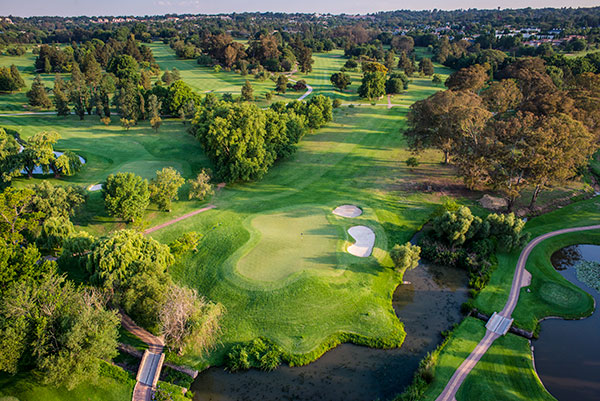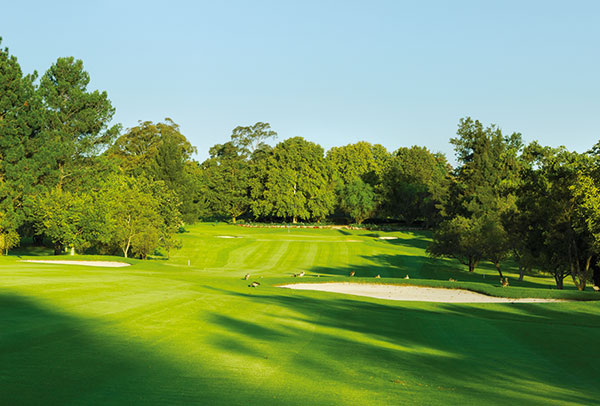As one drives around the leafy, affluent neighbourhood of Bryanston, it is difficult to imagine a time before the sprawl of the northern suburbs of Johannesburg had reached this area – about 75 years ago.
It was during the post-WW II boom that Bryanston Country Club was founded, although it was as early as 1938 that the idea was first mooted to establish a new residential suburb complete with its own country club.
The property earmarked for development, some 20 kilometres north of downtown Johannesburg, was indeed ‘in the sticks’, and William Nicol Drive was then a sand road that serviced farms in the area. But, because of the hostilities in Europe that escalated into the Second World War, this and other property developments stalled. The brainchild of the property arm of Anglo American, 120 hectares had been set aside for the country club, but even after the war property sales of the acre-sized (and some larger) stands were sluggish. Those investors who had acquired land and built homes became anxious about their country club, which by 1947 was still nothing more than an undulating savannah devoid of trees.
A committee of residents was formed, and it was agreed that the land would be sold to the club for the princely sum of £30 000, and a loan of £75 000 would also be made to the fledgling club for the construction of the course and clubhouse. Even given the relatively low property prices at the time, this was certainly a bargain, and the enthusiastic founding fathers of the club decided to commission Charles Hugh Alison to design the layout.
The first par three on the course is the 168-metre 4th hole.
Alison, an Oxford graduate who had formed a partnership with the legendary Harry Colt, had made quite a name for himself by this time, and his courses were known for excessive bunkering and his insistence that the player should be forced to play approach shots to the green from the correct portion of the fairway. Many architects have since adopted this design philosophy.
Work on the new course began in 1949, and although the design was not one of Alison’s more penal creations, the result was two well-routed, nine-hole loops that featured an excellent mix of holes. Alison could never be accused of copying other designers, and his consecutive par fives to begin the round is a radical departure from the norm.
A tree-planting programme transformed the open veld to a true parkland beauty, and even before the trees had reached their full heights, the course was declared to be one of the finest in the greater Johannesburg area.
Making the most of the undulating terrain, Alison was careful to ensure that each hole had its own character, and designed them to demand an equal measure of draws and fades.
The course superintendent at the club, Ronnie Cousins, is a former golf professional who has a clear understanding of how to maintain and set up a course, and he makes the point that more than at other Highveld courses, the difference between playing this course in summer and winter is considerable. “The side-sloping fairways affect the bounce and roll of the ball far more in winter, and although our layout is not the longest (6 700m), in summer when our kikuyu is lush, at full stretch the layout can be a monster,” he says.
Over the years, a lot of work has gone into improving and modernising the course, and the most contentious issue was the remodelling of the greens. In an effort to introduce more slope on the putting surfaces, there are those who might suggest that the designer went overboard, and there are some wicked, roller-coaster areas that limit pin positions.
The par-five 17th hole is the last real birdie opportunity at Bryanston CC.
It has been suggested that the putting surfaces will be reshaped sometime in the future, but in the meantime, when these greens are running at tournament speeds, they are certainly interesting and present a great test of a player’s green-reading skills.
This club with its large membership must be considered one of the most successful in the industry, but it has had to endure more than one setback during its history.
The first nine holes were opened in 1951 by Anglo’s Ernest Oppenheimer, at which time the Tudor-styled clubhouse housed a dining room, members’ lounge, kitchen, pro shop, locker-rooms and workshop within the one structure. After only two years of being in operation, disaster struck when during a winter ball, a fire broke out and the new clubhouse was razed to the ground.
Construction of a new clubhouse began immediately and was completed in February 1955, at which time the club’s badge was changed to feature the mythical phoenix rising from the ashes. This also coincided with the completion of the second nine holes. This occasion was celebrated with an exhibition match between some of the top professionals of the era – Bobby Locke, Otway Hayes, George Farmer and Jimmy Bullock (who would go on to serve the club for many years as the club professional).
Over the next few years, the clubhouse was extended to accommodate the popularity of the facility and the increasing number of members, but unfortunately in 1976, 23 years after the first fire, another one broke out, but was fortunately contained by the swift response of the Sandton Fire Department.
With all respect to the designer of the second clubhouse, it always seemed somewhat disjointed, and hardly did the club justice. That was recently rectified, and after considerable work (and expense), the entrance to the club and its reception area is now worthy of its status.
Various other changes have been made to the main and surrounding structures and the main bar opens up onto a patio overlooking the course, while the pro shop was also enlarged.
The course and facilities at Bryanston Country Club are superb, making it one of our five-star golfing destinations.
Special mention must be made of the attitude of the management and staff at Bryanston, and as general manager Paul Leishman explains: “Member and guest satisfaction is important to all our staff and is the core of our daily function.” Leishman has developed a system of regular surveys that monitor satisfaction levels – and his team certainly cannot be accused of slacking off. It is encouraging to find a club operation that never ceases to look for ways to improve, and over the past five years, Bryanston has established itself a true five-star facility.
Unfortunately, as property prices around the course rocketed, the large properties were subdivided and the traffic congestion in the area has become a major problem, but once one enters this club’s grounds, it is like entering another world, and the far-sighted vision of the original developers can beappreciated.
FACT FILE
GETTING THERE: Heading north from Sandton along William Nicol Drive, turn left into Bryanston Drive and proceed until the club entrance on the left.
COURSE: Classic parkland, par 72 – kikuyu tees and fairways, L93 bent-grass greens
DESIGNER: Charles Hugh Alison – opened 1951.
GENERAL MANAGER: Paul Leishman
COURSE SUPERINTENDENT: Ronnie Cousins
PGA PROFESSIONAL: Andrew Wildman
CLUB CAPTAIN: Rob Clouston
GREENFEES: Prime times – accompanied by a member – R420, unaccompanied by a member – R470
CONTACT: Tel: 011 706 1361
WEBSITE: www.bryanstoncc.co.za
LIKES
• The course – a good balance between playability and being challenging enough to keep the better player’s attention.
• The revamped clubhouse – it is tasteful, opulent and practical.
DISLIKES
• An advert for a bank near the entrance to the club – an example of tacky commercialism that a club like this doesn’t need.
• Getting to and from the club during peak traffic times.
MAKE THE BEST OF EVERY TERRRAIN
Mercedes-Benz has a range of SUVs designed to meet the needs of a driver who knows what he wants. Whether you are looking for versatility, innovation, comfort, or something sporty to express your individuality, we have the best.
The SUV range is led by the G-Class, which is the most capable production SUV in the market. It has a deep heritage – which flows down into the bloodline of the rest of our SUV range and, with continuously improved technology and high-class equipment specifications, the range consistently satisfies the highest expectations of its off-road fans. This means that your 4MATIC SUV is more than capable of conquering any rocky off-road terrain, while still affording you the finest in comfort on your urban adventures.
For more information, visit www.everyterrain.co.za.











